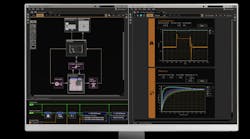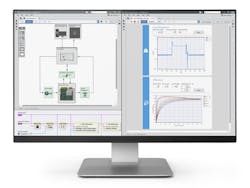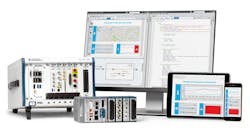NI Answers the Call for Flexibility with Automated Test Software
Download this article as a .PDF
There is no question that National Instruments’ (NI) LabVIEW software has a long and distinguished history. Last year, NI made major headlines by introducing LabVIEW NXG, which the company describes as the next generation of LabVIEW. NI is continuing its momentum with its recent announcement of a new release of LabVIEW NXG. NI asserts that this new version inttoduces key functionality for engineers involved with automated test-and-measurement systems.
Enhancing the Automated Test Workflow
So what are the enhancements that this new version of LabVIEW NXG offers? And what prompted NI to provide them in the first place? “The technologies that are embedded inside of test-and-measurement equipment are accelerating in performance at exponential rates,” explained David Hall, senior product marketing manager for RF and communications at NI. “Our approach for serving that capability to customers is through a flexible software-centric approach.”
Let’s first take a look at the role of a typical test engineer. “When we look at how customers use our software to build an automated test system, there are probably a number of different steps that they go through that historically have all been pretty discrete,” said Hall. “A test engineer typically gets a spec sheet, a measurement list, or a test plan to start with. This documentation tells the engineer what results are needed for which set of measurements at which set of frequencies or under what operating conditions.
“What a test engineer is responsible for is to translate that set of requirements into a test system,” he continued. “That starts with procuring hardware, assembling that hardware, and starting to develop the code for each individual test module for each individual test. The process also involves troubleshooting and making sure measurements are accurate through an interactive measurement experience, eventually automating those measurements, and then reporting the results.”
Figure 1 shows an automated test system workflow. NI’s goal is to essentially simplify the middle sections of this workflow (shown in yellow in Fig. 1). “In each of those areas, the way in which we are attempting to help those engineers is to effectively reduce the time it takes to do those tasks,” Hall noted, referring to those middle sections.
1. This figure illustrates an automated test system workflow. The yellow blocks represent the areas that NI is aiming to boost.
Let’s look at just how NI intends to accomplish these goals. Anyone who has spent time in a test lab knows that a test bench typically consists of a number of different test instruments that are often manufactured by different vendors. These instruments are also likely to vary in age. Given these dissimilarities, Hall noted, it can be a challenge to get all of the instruments in a test bench to work together.
“In a typical test bench that many of our customers might start with,” he said, “there is a challenge from an automation perspective—the automation technologies for some of the instruments might be different. There are challenges with synchronization—the way that you synchronize them may all be different. There are issues with programming, particularly because the driver software for each of these instruments is often very different. That creates a level of complexity that test engineers typically have to wade through by themselves.”
To overcome these challenges, NI is offering a new feature in LabVIEW NXG called SystemDesigner (Fig. 2). “SystemDesigner is a diagram that allows engineers to configure the hardware they have present in their test system,” explained Hall. “That includes a combination of PXI hardware or other NI hardware, as well as other third-party instruments.”
2. SystemDesigner helps users check a system’s configuration as its being built, thus simplifying the process of building test systems.
Let’s explain a little of what SystemDesigner can offer. For one, when using NI hardware in a test system, SystemDesigner allows engineers to see specific details concerning that hardware. This information can include connector pinouts, the manual for the specific instrument, and more.
SystemDesigner also supports third-party instruments in a test system. “SystemDesigner can connect engineers to the driver software for third-party instruments—in part because many of those drivers are hosted on ni.com,” Hall said. “From the SystemDesigner view, you can find out which drivers you need to control hardware and install and manage the driver installation from within the LabVIEW environment. That actually can save a lot of time, as it’s often difficult to find the most appropriate version of the driver—particularly if you’re using instruments from multiple vendors.”
SystemDesigner lets users operate in either Live or Design mode. “When you’re in Live mode, the software goes out and looks to see what instruments are connected,” said Hall. “When you’re in Design mode, you can configure a hypothetical system that you want to put together. So you can configure a SystemDesigner view before you actually procure your instruments. That helps you to identify which instruments you need and what software you’re going to need before you physically have those instruments.”
A Web-Based Approach
SystemDesigner is not the only new feature offered in the latest release of LabVIEW NXG. The other new aspect involves today’s web technologies. “The other set of challenges we’re attempting to solve with the latest iteration of NXG involves serving data through the right mechanisms—particularly using web technologies,” Hall explained. “When talking with many of our customers, we get a tremendous amount of feedback concerning their desire for doing remote configurations, remotely operating instruments, potentially real-time monitoring measurements, and having the capability to view data offline.”
As an example, remote operation and monitoring is clearly a necessity if a test system is located in a dangerous environment—one obviously wouldn’t want to be physically present with that test system. Some of today’s web technologies have made remote operation and monitoring much easier through a web-based approach.
“The use of web technologies could be pretty useful, particularly when you want your test system configured in a closed environment where you don’t want physical access,” Hall said. “There a number of web technologies that engineers could use themselves to enable remote data access, but it’s honestly pretty complicated. Only a pretty small group of individuals have the knowledge set that a typical test engineer is required to have. If you were to add detailed knowledge of web programming tools and client/server communications, you further limit your pool of individuals. The result is you either have to go and learn a whole bunch of new technology, or you have to outsource some aspects of that project.”
So just what is NI hoping to achieve? Hall explained: “What we’re attempting to do with LabVIEW NXG is abstract some of the difficulty and make it really accessible to create polished, professional web user interfaces (UIs) within the LabVIEW environment. And we’re doing that through some pretty standard technologies like HTML and JavaScript. We’re doing it in a way such that the users themselves can actually host the UI on local servers.”
Let’s now talk about the new LabVIEW NXG Web Module, which is the actual product that NI now offers that makes what was just said a reality (Fig. 3). The LabVIEW NXG Web Module, which works within the LabVIEW NXG environment, lets users create web-based UIs to remotely control and monitor test-and-measurement systems.
3. The LabVIEW NXG Web Module enables users to create UIs that can run in modern web browsers without plug-ins or installers.
WebVIs lie at the heart of the LabVIEW NXG Web Module. WebVIs are essentially LabVIEW VIs that allow users to build UIs via drag-and-drop widgets. WebVIs are based on standard web technologies, such as HTML, CSS, and JavaScript, meaning UIs that are created can be viewed in any modern web browser.
In addition, LabVIEW actually scripts HTML, CSS, and JavaScript as a UI is being created. This generated code can be accessed at any time, allowing engineers to customize the code to meet their specific needs.
To summarize, this latest release of LabVIEW NXG offers new capabilities that are sure to be highly beneficial for engineers involved with automated test-and-measurement systems. SystemDesigner is sure to save test engineers a great deal of time, while the web-based capabilities add a new dimension to developing automated test-and-measurement systems. Test engineers all over are sure to take advantage of these latest tools.




